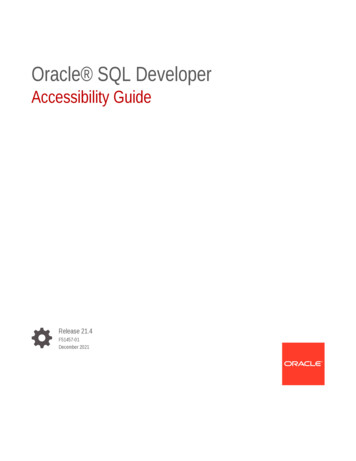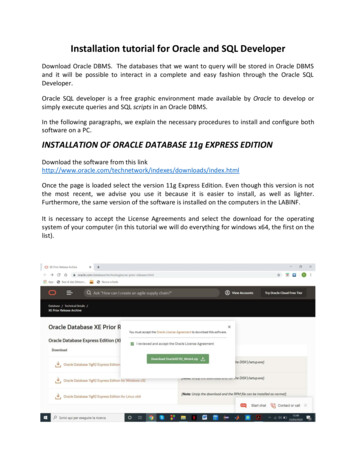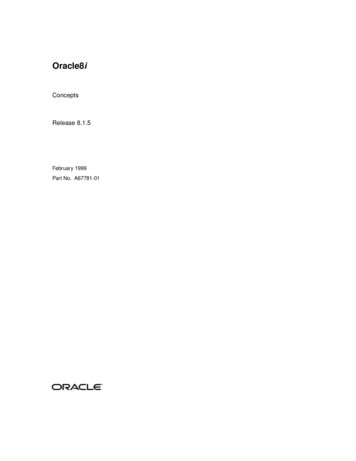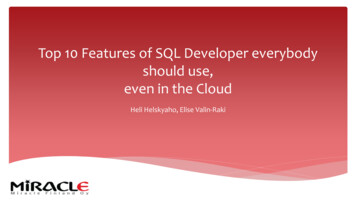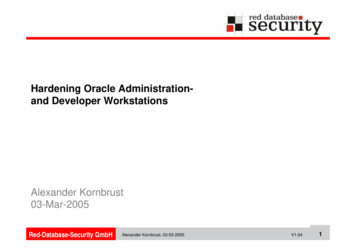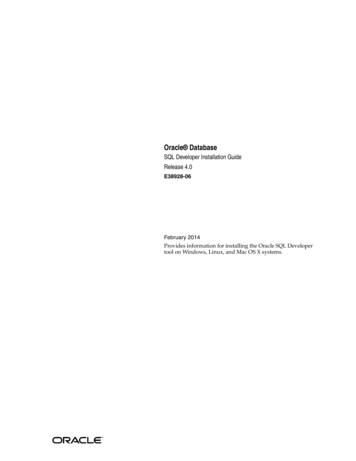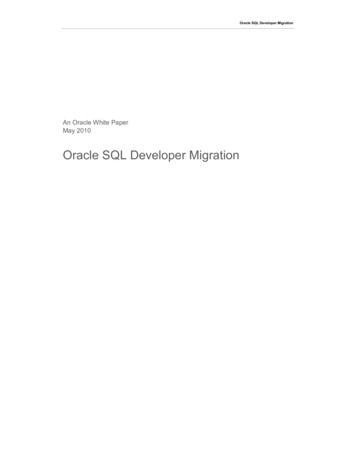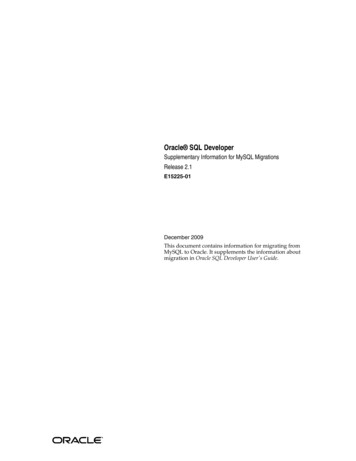
Transcription
Oracle SQL DeveloperSupplementary Information for MySQL MigrationsRelease 2.1E15225-01December 2009This document contains information for migrating fromMySQL to Oracle. It supplements the information aboutmigration in Oracle SQL Developer User's Guide.
Oracle SQL Developer Supplementary Information for MySQL Migrations, Release 2.1E15225-01Copyright 1998, 2009, Oracle and/or its affiliates. All rights reserved.Primary Author:Chuck MurrayThis software and related documentation are provided under a license agreement containing restrictions onuse and disclosure and are protected by intellectual property laws. Except as expressly permitted in yourlicense agreement or allowed by law, you may not use, copy, reproduce, translate, broadcast, modify, license,transmit, distribute, exhibit, perform, publish, or display any part, in any form, or by any means. Reverseengineering, disassembly, or decompilation of this software, unless required by law for interoperability, isprohibited.The information contained herein is subject to change without notice and is not warranted to be error-free. Ifyou find any errors, please report them to us in writing.If this software or related documentation is delivered to the U.S. Government or anyone licensing it onbehalf of the U.S. Government, the following notice is applicable:U.S. GOVERNMENT RIGHTS Programs, software, databases, and related documentation and technical datadelivered to U.S. Government customers are "commercial computer software" or "commercial technical data"pursuant to the applicable Federal Acquisition Regulation and agency-specific supplemental regulations. Assuch, the use, duplication, disclosure, modification, and adaptation shall be subject to the restrictions andlicense terms set forth in the applicable Government contract, and, to the extent applicable by the terms ofthe Government contract, the additional rights set forth in FAR 52.227-19, Commercial Computer SoftwareLicense (December 2007). Oracle USA, Inc., 500 Oracle Parkway, Redwood City, CA 94065.This software is developed for general use in a variety of information management applications. It is notdeveloped or intended for use in any inherently dangerous applications, including applications which maycreate a risk of personal injury. If you use this software in dangerous applications, then you shall beresponsible to take all appropriate fail-safe, backup, redundancy, and other measures to ensure the safe useof this software. Oracle Corporation and its affiliates disclaim any liability for any damages caused by use ofthis software in dangerous applications.Oracle is a registered trademark of Oracle Corporation and/or its affiliates. Other names may be trademarksof their respective owners.This software and documentation may provide access to or information on content, products, and servicesfrom third parties. Oracle Corporation and its affiliates are not responsible for and expressly disclaim allwarranties of any kind with respect to third-party content, products, and services. Oracle Corporation andits affiliates will not be responsible for any loss, costs, or damages incurred due to your access to or use ofthird-party content, products, or services.
ContentsPreface . vAudience.Documentation Accessibility .Related Documents .Conventions .Third-Party License Information.1Introduction2Oracle and MySQL ComparedvvviviviDatabase Security . 2-1Database Authentication. 2-1Privileges . 2-1Schema Migration . 2-2Schema Object Similarities. 2-2Schema Object Names . 2-3Table Design Considerations. 2-4Character Data Types . 2-4Column Default Value . 2-5Migrating Multiple Databases. 2-5Schema Migration Considerations for MySQL. 2-5Databases. 2-5Mapping MySQL Global and Database-Level Privileges to Oracle System Privileges. 2-5Temporary Tables . 2-6Owner of Schema Objects . 2-6Data Types . 2-7Supported Oracle Data Types . 2-7Default Data Type Mappings . 2-8Comparing Data Types . 2-9Numeric Types . 2-9Date and Time Types. 2-10String Types . 2-10Data Storage Concepts. 2-11iii
3Triggers and Stored ProceduresTriggers .Stored Procedures.Individual SQL Statements.REPLACE Statement .DO Statement.Compound DECLARE Statement .Compound SET Statement .Variables in Stored Procedures .Error Handling in Stored Procedures ng the User Account. 4-1Dumping MySQL Data . 4-1Optimizing Command Line Options . 4-2Indexiv
PrefaceOracle SQL Developer Supplementary Information for MySQL Migrations describes severaldifferences between MySQL and Oracle. It also outlines how those differences aredealt with by SQL Developer during the migration process.AudienceThis guide is intended for anyone who is involved in converting a MySQL database toOracle using SQL Developer.You should be familiar with relational database concepts and with the operatingsystem environments under which you are running Oracle and MySQL.Documentation AccessibilityOur goal is to make Oracle products, services, and supporting documentationaccessible to all users, including users that are disabled. To that end, ourdocumentation includes features that make information available to users of assistivetechnology. This documentation is available in HTML format, and contains markup tofacilitate access by the disabled community. Accessibility standards will continue toevolve over time, and Oracle is actively engaged with other market-leadingtechnology vendors to address technical obstacles so that our documentation can beaccessible to all of our customers. For more information, visit the Oracle AccessibilityProgram Web site at http://www.oracle.com/accessibility/.Accessibility of Code Examples in DocumentationScreen readers may not always correctly read the code examples in this document. Theconventions for writing code require that closing braces should appear on anotherwise empty line; however, some screen readers may not always read a line of textthat consists solely of a bracket or brace.Accessibility of Links to External Web Sites in DocumentationThis documentation may contain links to Web sites of other companies ororganizations that Oracle does not own or control. Oracle neither evaluates nor makesany representations regarding the accessibility of these Web sites.Deaf/Hard of Hearing Access to Oracle Support ServicesTo reach Oracle Support Services, use a telecommunications relay service (TRS) to callOracle Support at 1.800.223.1711. An Oracle Support Services engineer will handletechnical issues and provide customer support according to the Oracle service requestprocess. Information about TRS is available atv
http://www.fcc.gov/cgb/consumerfacts/trs.html, and a list of phonenumbers is available at http://www.fcc.gov/cgb/dro/trsphonebk.html.Related DocumentsFor information about using Oracle SQL Developer, see Oracle SQL Developer User'sGuide and the SQL Developer online help.For information about installing Oracle SQL Developer, see Oracle SQL DeveloperInstallation Guide.Oracle error message documentation is only available in HTML. If you only haveaccess to the Oracle Documentation CD, you can browse the error messages by range.Once you find the specific range, use your browser's "find in page" feature to locate thespecific message. When connected to the Internet, you can search for a specific errormessage using the error message search feature of the Oracle online documentation.To download free release notes, installation documentation, white papers, or othercollateral, go to the Oracle Technology Network (OTN). You must register onlinebefore using OTN; registration is free and can be done athttp://www.oracle.com/technology/membershipIf you already have a user name and password for OTN, then you can go directly tothe documentation section of the OTN Web site nventionsThe following text conventions are used in this document:ConventionMeaningboldfaceBoldface type indicates graphical user interface elements associatedwith an action, or terms defined in text or the glossary.italicItalic type indicates book titles, emphasis, or placeholder variables forwhich you supply particular values.monospaceMonospace type indicates commands within a paragraph, URLs, codein examples, text that appears on the screen, or text that you enter.Third-Party License InformationOracle SQL Developer contains third-party code. Oracle is required to provide thefollowing notices. Note, however, that the Oracle program license that accompaniedthis product determines your right to use the Oracle program, including thethird-party software, and the terms contained in the following notices do not changethose rights.Apache Regular Expression Package 2.0Licensed under the Apache License, Version 2.0 (the "License"); you may not use thisfile except in compliance with the License. You may obtain a copy of the License s required by applicable law or agreed to in writing, software distributed underthe License is distributed on an "AS IS" BASIS, WITHOUT WARRANTIES ORvi
CONDITIONS OF ANY KIND, either express or implied. See the License for thespecific language governing permissions and limitations under the License.Antlr v 2.7.3http://www.antlr.org/rights.htmlOracleAS TopLink uses Antlr for EJB QL parsing. Antlr (ANother Tool for LanguageRecognition), is a language tool that provides a framework for constructingrecognizers, compilers, and translators from grammatical descriptions containing C or Java actions. The ANTLR parser and translator generator is fully in the publicdomain.JGoodies Looks and FormsCopyright 2003 JGoodies Karsten Lentzsch. All rights reserved.Redistribution and use in source and binary forms, with or without modification, arepermitted provided that the following conditions are met: Redistributions of source code must retain the above copyright notice, this list ofconditions and the following disclaimer.Redistributions in binary form must reproduce the above copyright notice, this listof conditions and the following disclaimer in the documentation and/or othermaterials provided with the distribution.Neither the name of JGoodies Karsten Lentzsch nor the names of its contributorsmay be used to endorse or promote products derived from this software withoutspecific prior written permission.THIS SOFTWARE IS PROVIDED BY THE COPYRIGHT HOLDERS ANDCONTRIBUTORS "AS IS" AND ANY EXPRESS OR IMPLIED WARRANTIES,INCLUDING, BUT NOT LIMITED TO, THE IMPLIED WARRANTIES OFMERCHANTABILITY AND FITNESS FOR A PARTICULAR PURPOSE AREDISCLAIMED. IN NO EVENT SHALL THE COPYRIGHT OWNER ORCONTRIBUTORS BE LIABLE FOR ANY DIRECT, INDIRECT, INCIDENTAL,SPECIAL, EXEMPLARY, OR CONSEQUENTIAL DAMAGES (INCLUDING, BUTNOT LIMITED TO, PROCUREMENT OF SUBSTITUTE GOODS OR SERVICES; LOSSOF USE, DATA, OR PROFITS; OR BUSINESS INTERRUPTION) HOWEVER CAUSEDAND ON ANY THEORY OF LIABILITY, WHETHER IN CONTRACT, STRICTLIABILITY, OR TORT (INCLUDING NEGLIGENCE OR OTHERWISE) ARISING INANY WAY OUT OF THE USE OF THIS SOFTWARE, EVEN IF ADVISED OF THEPOSSIBILITY OF SUCH DAMAGE.vii
viii
11IntroductionThis document provides supplementary reference information for migrating MySQLdatabases to Oracle using the Oracle SQL Developer tool. It includes information tohelp you plan for the migration and to solve any problems that might occur during orafter the migration.You should already know how to use the SQL Developer tool, including its migrationcapabilities. SQL Developer is described in Oracle SQL Developer User's Guide and inthe online help.The following supplementary reference information is available: Chapter 2, "Oracle and MySQL Compared" Chapter 3, "Triggers and Stored Procedures" Chapter 4, "Troubleshooting"Introduction 1-1
1-2 Oracle SQL Developer Supplementary Information for MySQL Migrations
22Oracle and MySQL ComparedThis chapter compares the MySQL database and the Oracle database. It includes thefollowing sections: Database Security Schema Migration Data Types Data Storage Concepts2.1 Database SecurityThis section includes information about security issues with MySQL databases andOracle databases.As with Oracle, MySQL users are maintained by the database. MySQL uses a set ofgrant tables to keep track of users and the privileges that they can have. MySQL usesthese grant tables when performing authentication, authorization and access controlfor users.2.1.1 Database AuthenticationUnlike Oracle (when set up to use database authentication) and most other databasesthat use only the user name and password to authenticate a user, MySQL uses anadditional location parameter when authenticating a user. This locationparameter is usually the host name, IP address, or a wildcard (“%”). With thisadditional parameter, MySQL may further restrict a user access to the database to aparticular host or hosts in a domain. Moreover, this also allows a different passwordand set of privileges to be enforced for a user depending on the host from which theconnection is made. Thus, user scott, who logs on from abc.com may or may not thesame as user scott who logs on from xyz.com.2.1.2 PrivilegesThe MySQL privilege system is a hierarchical system that works through inheritance.Privileges granted at a higher level are implicitly passed down to all lower levels andmay be overridden by the same privileges set at lower levels. MySQL allows privilegesto be granted at five different levels, in descending order of the scope of the privileges: Global Per-host basis Database-levelOracle and MySQL Compared 2-1
Schema Migration Table-specific Column-specific (single column in a single tableEach level has a corresponding grant table in the database. When performing aprivilege check, MySQL checks each of the tables in descending order of the scope ofthe privileges, and the privileges granted at a lower level take precedence over thesame privileges granted at a higher level.The privileges supported by MySQL are grouped into two types: administrativeprivileges and per-object privileges. The administrative privileges are global privilegesthat have server-wide effects and are concerned with the functioning of MySQL. Theseadministrative privileges include the FILE, PROCESS, REPLICATION, SHUTDOWNand SUPER privilege. The per-object privileges affect database objects such tables,columns, indexes, and stored procedures, and can be granted with a different scope.These per-object privileges are named after the SQL queries that trigger their checks.Unlike in Oracle, there is no concept of role in MySQL. Thus, in order to grant a groupof users the same set of privileges, the privileges have to be granted to each userseparately. Alternately, though less satisfactory for auditing, users performing tasks asa role may all share a single user account that is designated for the "role" and with therequired privileges granted.2.2 Schema MigrationThe schema contains the definitions of the tables, views, indexes, users, constraints,stored procedures, triggers, and other database-specific objects. Most relationaldatabases work with similar objects.This section contains the following: Schema Object Similarities Schema Object Names Table Design Considerations Migrating Multiple Databases Schema Migration Considerations for MySQL2.2.1 Schema Object SimilaritiesThere are many similarities between schema objects in Oracle and MySQL. However,some schema objects differ between these databases. For more information aboutschema objects, see Oracle SQL Reference.Table 2–1 shows the differences between Oracle and MySQL.Table 2–1Schema Objects in Oracle and MySQLOracleMySQLAFTER triggertriggerBEFORE triggertriggerCheck constraintCheck constraintColumn defaultColumn defaultDatabaseDatabaseForeign keyForeign key2-2 Oracle SQL Developer Supplementary Information for MySQL Migrations
Schema MigrationTable 2–1 (Cont.) Schema Objects in Oracle and MySQLOracleMySQLIndexIndexPackageN/APL/SQL functionRoutinePL/SQL procedureRoutinePrimary keyPrimary keyRoleN/ASchemaSchemaSequenceAUTO INCREMENT for a Temporary tableTemporary tableTrigger for each rowTrigger for each rowUnique keyUnique keyUserUserViewView2.2.2 Schema Object NamesOracle is case insensitive to object names, and Oracle schema object names are storedas uppercase.As in Oracle, column, index, stored procedure, and trigger names as well as columnaliases in MySQL are case insensitive on all platforms. However, the case sensitivity ofdatabase and tables names for MySQL differs from Oracle. In MySQL, databasescorrespond to directories within the data directory, and tables correspond to one ormore files within the database directory. As such, the case sensitivity of the databaseand table names is determined by the case sensitivity of the underlying operatingsystems. This means that database and table names are not case-sensitive in Windowsand are case-sensitive in most varieties of Unix. However, MySQL allows users todetermine how the database and table names are stored on disk and in their use inMySQL through the lower case table names system variable. Table aliases arecase-sensitive in releases before MySQL 4.1.1.Both Oracle and MySQL let you use reserved words as object names by representingthe name with a quoted identifier. However, MySQL allows some reserved wordssuch as DATE and TIMESTAMP to be used as unquoted identifier for object names,although this is not allowed in Oracle. SQL Developer appends an underscore ( ) tothe name of a MySQL object that is an Oracle reserved word.MySQL and Oracle have some minor differences in their definition of an identifier. InMySQL, an unquoted identifier may begin with a digit, and double quotation marksare allowed in a quoted identifier; however, neither of these is allowed in an Oracleidentifier. In MySQL, the quote character is the backtick ( ). If the SQL mode ANSIQUOTES is set, double quotes can also be used to quote the identifiers. In Oracle,identifiers are quoted using double quotation marks.Oracle and MySQL Compared 2-3
Schema MigrationYou should choose a schema object name that is unique by case and by at least oneother characteristic, and ensure that the object name is not a reserved word from eitherdatabase.2.2.3 Table Design ConsiderationsThis section discusses table design issues that you need to consider when convertingMySQL databases to Oracle. This section includes the following: Character Data Types Column Default Value2.2.3.1 Character Data TypesMySQL and Oracle have some differences in the character types that they support andin the way they store and retrieve the character type values.MySQL supports the CHAR and VARCHAR type for character type with a length thatis less than 65,535 bytes. The CHAR type can have a maximum length of 255 bytes,and as of MySQL 3.23 it may also be declared with a length of 0 byte. Before MySQL5.0.3, the length specification for the VARCHAR type is the same as the CHAR type.From MySQL 5.0.3 on, the maximum length for the VARCHAR type is 65,535 bytes.Oracle supports four character types: CHAR, NCHAR, NVARCHAR2 andVARCHAR2. The minimum length that can be declared for all Oracle character typesis 1 byte. The maximum size allowed for CHAR and NCHAR is 2,000 bytes, and forNVARCHAR2 and VARCHAR2 it is 4,000 bytes.MySQL CHAR values are right-padded with spaces to the specified length when theyare stored, and trailing spaces are removed when the values are retrieved. On theother hand, VARCHAR values are stored using as many characters as are given, butbefore MySQL 5.0.3 trailing spaces are removed when the values are stored andretrieved. Oracle blank-pads the value for its CHAR and NCHAR type to the columnlength if the value is shorter than the column length, and trailing spaces are notremoved on retrieval. For NVARCHAR2 and VARVHAR2 data type columns, Oraclestores and retrieves the value exactly as is given, including trailing spaces.If a value is assigned to a character type column that exceeds its specified length,MySQL truncates the value and does not generate an error unless the STRICT SQLmode is set. Oracle generates an error if the value assigned to a character type columnexceeds its specified length.In MySQL, every character type (CHAR, VARCHAR, and TEXT) column has a columncharacter set and collation. If the character set or collation is not explicitly defined inthe column definition, the table character set or collation is implied if specified;otherwise, the database character or collation is chosen. In Oracle, the character set forCHAR and VARCHAR2 types is defined by the database character set, and for thecharacter set for NCHAR and NVARCHAR types is defined the national character set.When declaring a CHAR or VARCHAR type in MySQL, the default length semanticsis characters instead of bytes for MySQL 4.1 and later. In Oracle, the default lengthsemantics is bytes for CHAR and VARCHAR2 types and characters for NCHAR andNVARCHAR2 types.SQL Developer will map MySQL CHAR and VARCHAR types to Oracle CHAR andVARCHAR2 types, respectively. SQL Developer will determine the maximum numberof bytes for the Oracle CHAR and VARCHAR2 data type columns from the number ofbytes required to hold the maximum length specified for the corresponding MySQLCHAR and VARCHAR data type columns. If the MySQL VARCHAR2 column is such2-4 Oracle SQL Developer Supplementary Information for MySQL Migrations
Schema Migrationthat the data exceeds 4000 bytes, convert the column to an Oracle CLOB data typecolumn.2.2.3.2 Column Default ValueMySQL differs from Oracle in the way it handles default value for a column that doesnot allow NULL value.In MySQL, for a column that does not allow NULL value and for which no data isprovided for the column when data is inserted into the table, MySQL determines adefault value for the column. This default value is the implicit default value for thecolumn data type. However, if the strict mode is enabled, MySQL generates errors,and for transactional tables it rolls back the insert statement.In Oracle, when data is inserted into a table, data must be provided for all columnsthat do not allow NULL value. Oracle does not generate a default value for columnsthat have the NOT NULL constraint.2.2.4 Migrating Multiple DatabasesSQL Developer supports the migration of multiple MySQL databases if they are on thesame MySQL database server.2.2.5 Schema Migration Considerations for MySQLSchema migration considerations for MySQL apply in the following areas: DatabasesMapping MySQL Global and Database-Level Privileges to Oracle SystemPrivileges Temporary Tables Owner of Schema Objects2.2.5.1 DatabasesWhen migrating MySQL databases to Oracle, SQL Developer maps each MySQLdatabase to a tablespace in Oracle. Database objects, such as tables, indexes and viewsare stored in the respective tablespaces and are referenced from the Oracle schema forthe user that owns them.2.2.5.2 Mapping MySQL Global and Database-Level Privileges to Oracle SystemPrivilegesSQL Developer does not process all the administrative privileges on MySQL, exceptthe SUPER privilege. Table 2–2 shows the mappings for MySQL per-object privilegesgranted at the different levels as well as the SUPER privilege granted at the globallevel.Table 2–2MySQL Privileges and Oracle System PrivilegesLevelPrivilegeSystem Privilege(s) on OracleGlobalALTERALTER ANY TABLE, ALTER ANY SEQUENCE,ALTER ANY CUSTER, COMMENT ANY TABLEGlobalALTER ROUTINEALTER ANY PROCEDURE, DROP ANY PROCEDUREOracle and MySQL Compared 2-5
Schema MigrationTable 2–2 (Cont.) MySQL Privileges and Oracle System PrivilegesLevelPrivilegeSystem Privilege(s) on OracleGlobalCREATECREATE ANY TABLE, CREATE ANY SEQUENCE,CREATE ANY CLUSTER, CREATE DATABASE LINK,COMMENT ANY TABLEGlobalCREATE ROUTINECREATE ANY PROCEDUREGlobalCREATE USERCREATE USER, GRANT ANY PRIVILEGEGlobalCREATE VIEWCREATE ANY VIEWGlobalDELETEALTER ANY TABLE, DROP USER, DELETE ANYTABLEGlobalDROPDROP ANY TABLE, DROP ANY SEQUENCE, DROPANY CLUSTER, DROP ANY VIEWGlobalEXECUTEEXECUTE ANY PROCEDUREGlobalINDEXCREATE ANY INDEX, ALTER ANY INDEX, DROPANY INDEXGlobalINSERTINSERT ANY TABLEGlobalLOCK TABLESLOCK ANY TABLEGlobalSELECTSELECT ANY TABLEGlobalSUPERCREATE ANY TRIGGER, DROP ANY TRIGGERGlobalUPDATEUPDATE ANY TABLEGlobalUSAGECREATE SESSION, ALTER SESSION, UNLIMITEDTABLESPACEDatabaseCREATECREATE CLUSTER, CREATE DATABASE LINK,CREATE SEQUENCE, CREATE TABLEDatabaseCREATE ROUTINECREATE PROCEDUREDatabaseCREATE VIEWCREATE VIEWTableCREATECREATE TABLETableCREATE VIEWCREATE VIEW2.2.5.3 Temporary TablesSQL Developer does not support the migration of temporary tables.In MySQL, temporary tables are database objects that are visible only to the currentuser session and are automatically dropped when the user session ends.The definition of temporary tables in Oracle differs slightly from MySQL, in that thetemporary tables, once created, exist until they are explicitly dropped and they arevisible to all sessions with appropriate privileges. However, the data in the temporarytables is visible only to the user session that inserts the data into the table, and the datamay persist for the duration of a transaction or a user session.2.2.5.4 Owner of Schema ObjectsSQL
Oracle SQL Developer Supplementary Information for MySQL Migrations describes several differences between MySQL and Oracle. It also outlines how those differences are dealt with by SQL Developer during the migration process. Audience This guide is intended for anyone who is involved in converting a MySQL database to Oracle using SQL Developer.

